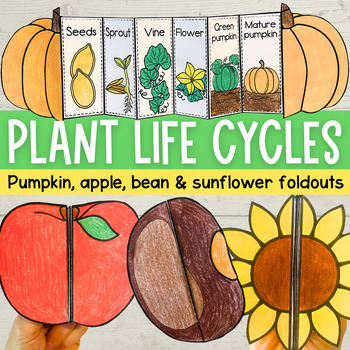Plant life cycle foldable sequencing activities - sunflower pumpkin apple bean
- Zip
What educators are saying
Products in this Bundle (4)
Also included in
- Explore a variety of plant and animal life cycles with this resource bundle of fun, foldable activities. These cut-and-paste sequencing printables are a hands-on alternative to science worksheets and are differentiated so you can use the templates best suited to your learners. Use them for your seasPrice $14.99Original Price $24.15Save $9.16
Description
These foldable cut-and-paste sequencing activities are a fun way to review the life cycle of a plant with your students and are an engaging alternative to a worksheet. This bundle contains differentiated PDF templates for 4 different plant life cycles - pumpkin, apple tree, bean plant, and sunflower.
Benefits of this activity
- Low prep
- Children learn about the life cycle in a fun and hands-on way, that’s a bit different from a standard science worksheet.
- Can be used to introduce the life cycle, or as a review/assessment to check understanding.
- Encourages fine motor/scissor skills, hand-eye coordination (folding), and sequencing.
- Differentiated options allow for multiple age ranges or abilities to do the same activity.
- Finished foldouts can be inserted into an interactive notebook where they can be referenced by children.
Multiple template options
For each plant, you'll find at least 3 options (e.g. students color, cut, and fold the template, or students sequence the life cycle stages before cutting and folding).
The finished foldouts are ideal for interactive science notebooks or as part of a lap book. Use them to support life cycle, plants, or seasonal changes units, as a science center, or as a homework activity for parents to complete with their children.
Please note, the templates are not editable. Instructions for students are provided including guidance on how to fold. Younger children may need extra support with cutting and folding.
What teachers are saying:
⭐⭐⭐⭐⭐'This is an amazing resource. We used apples for September, and we are excited to use the others throughout the year. Easy to use with a couple of different options.'
⭐⭐⭐⭐⭐'My students absolutely loved making the pumpkin life cycle book! It was so engaging for them and they were all very proud of their work. They were able to recite the life cycle correctly after our lesson using these books.'
⭐⭐⭐⭐⭐'Easy to prep and use with my students! They love foldable books and they can bring it home to share what they learned about life cycles with their families.'
⭐⭐⭐⭐⭐'Great tool to review the steps and recall the order of the life cycle.'
⭐⭐⭐⭐⭐'I really appreciated that there were different styles to choose from for each cycle. This made it easy to differentiate for my class!'
⭐⭐⭐⭐⭐'This was an excellent addition to my science lessons!'
Keep up to date with my newest resources by following my store, Wonder at the World.






